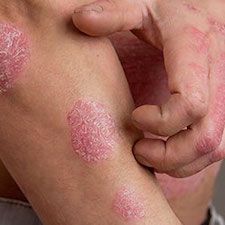Article
Early Guselkumab for Psoriasis: Increased Super-Responder Likelihood in Short Disease Duration
Author(s):
Early intervention was shown to lead to better clinical responses, results which could translate to long-term improvements in psoriasis and sustained maintenance of response after withdrawal.

Guselkumab is effective and safe on the skin and systemically across various subpopulations of individuals with psoriasis, according to new findings, and early intervention may help to improve patients’ clinical outcomes.1
These findings resulted from an interim analysis of the ongoing GUIDE study, which assessed early disease intervention’s impact on clinical responses following 28 total weeks of guselkumab in those with moderate-to-severe plaque psoriasis.
The research was authored by Knut Schäkel, from the Department of Dermatology and the Interdisciplinary Center for Inflammatory Diseases at Heidelberg University Hospital in Germany.
“This analysis is distinct from the primary objective of the study, which is to demonstrate that SRes maintain disease control at W68 with prolonged treatment intervals,”Schäkel and colleagues wrote. “The study will also assess whether early intervention results in better clinical responses and a more durable maintenance of response following drug withdrawal.”
Background and Findings
The investigators noted that the GUIDE study is a double-blind, randomized phase IIIb trial conducted on adult study participants who have a diagnosis of psoriasis. Part 1 of this study focused on patients categorized into 2 groups based on their disease duration: short disease duration (SDD) of 2 years or less, and long disease duration (LDD) of more than 2 years.
These patients were given guselkumab 100 mg at specific intervals from Weeks 0 - 28. Within the timeframe of Weeks 20 - 28, those individuals who achieved complete clearance of their skin were considered super responders (SRe).
To examine the factors associated with being an SRe, a multivariable logistic regression analysis was performed using baseline factors. Additionally, the relationship between clinical response, disease duration, and serum biomarker data was assessed at Weeks 0 and 4.
The investigators’ primary aim was to determine the percentage of those achieving an absolute PASI score below 3 at Week 68. In addition, several secondary endpoints were analyzed and presented in this analysis.
These secondary endpoints included the time it took for participants to reach PASI75/90 and PASI=0 responses from baseline, specifically comparing individuals with SDD and LDD and comparing SRes and non-SRes for PASI=0.
The research team also examined the rates of PASI response over time, including at Weeks 20 and 28, in each patient group, considering relative PASI75/90 and absolute PASI scores below 3, 1, and 0.
Furthermore, another evaluated element was the proportion of participants who achieved a DLQI score of 0/1 at 28 weeks. The safety of the treatment was evaluated by monitoring adverse events using MedDRA-defined terms.
The research team recruited a total of 880 individuals, with 40.6% having SDD and 59.4% having LDD. More SDD participants achieved complete skin clearance PASI score of 0 at 28 weeks compared to LDD patients (51.8% compared to 39.4%).
SDD participants also had a higher likelihood of being SRes (43.7% compared to 28.1%, overall 34.4%). SDD participants were found to have achieved PASI=0 faster than LDD patients, with a median of 141 days versus 200 days. The team noted that disease duration and prior use of biologics were shown to be the biggest factors influencing super-response, with no strong association found among other independent variables.
The investigators also noted that serum biomarker levels of IL-17A, IL-17F, IL-22, and β-defensin 2 substantially differed between SDD and LDD participants or between super-responders and non-super-responders at baseline.
“Guselkumab efficacy was consistent across subpopulations, on the skin and systemically,” they wrote. “The proportion of SRes was higher in SDD than LDD patients, indicating early treatment intervention may improve clinical outcomes.”
References
- Schäkel, K., Reich, K., Asadullah, K., et al. (2023). Early disease intervention with guselkumab in psoriasis leads to a higher rate of stable complete skin clearance (‘clinical super response’): Week 28 results from the ongoing phase IIIb randomized, double-blind, parallel-group, GUIDE study. Journal of the European Academy of Dermatology and Venereology, 35(1), e5-e6. https://doi.org/10.1111/jdv.19236.



